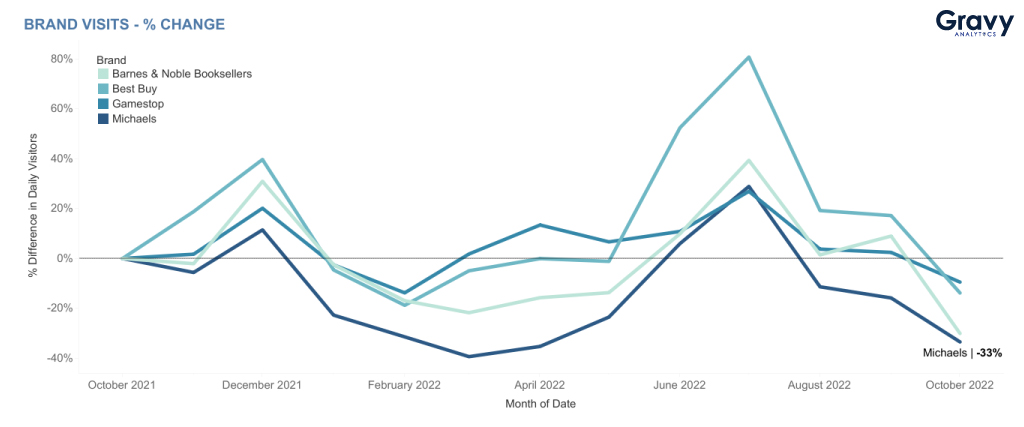Are U.S. Consumers Still Prioritizing Their Hobbies?
December 5, 2022

The pandemic impacted foot traffic for every industry in a variety of ways. For companies selling products for leisure activities and hobbies, the pandemic caused a surge of growth. As cooped up Americans dealt with boredom and isolation, many turned to their favorite leisure activities and took on new hobbies at home. But, the days of eating, working, and entertaining ourselves from home are gone for most of us. So, how is foot traffic looking for leisure and hobby-based retailers? We analyzed Barnes & Noble’s foot traffic along with Michaels, Best Buy, and GameStop to learn more.

Where Are Consumers Going—or Not Going?
From October 2021 to October 2022, the four companies we analyzed saw overall declines in foot traffic. Of the four, Michaels experienced the largest foot traffic decline with a -33% change YoY, while Barnes & Noble also saw a significant decline of 30%. Although they all followed a similar foot traffic pattern, GameStop ended October with a -9% change, decreasing the least in terms of foot traffic compared to the other three companies. Best Buy ended this October with a YoY change of -14%.

In summer, all four companies saw dramatic spikes in foot traffic, perhaps due to the increase in time many consumers have for leisure and hobbies during the summer as kids are off from school and many people take vacations. This spike was followed by a swift decline across the board. After this spike in traffic, Barnes & Noble’s foot traffic rose again during September, but quickly made its way down to the negatives. This slight increase was likely due to those purchasing supplies and books during the back-to-school shopping season. The companies analyzed are big players in their industries, so what is driving this decline in foot traffic?
Spending Habits Are Shifting
Put simply, consumers are splurging less and focusing on essentials right now. Due to inflation, the pandemic, and unemployment, times may seem uncertain for many consumers. Although job security and consumer confidence have increased this year, consumers continue to be cost-conscious while saving more.
Consumer trends are highlighting value and social activities, so personal hobbies may be on hold as consumers focus on connecting with each other. Fairly-priced social venues, shopping centers, and discount stores are attracting consumers this year, so what does this mean for leisure-focused businesses and their foot traffic?
Will Barnes & Noble’s Foot Traffic Bounce Back?
GameStop as we know it may not survive 2023, as more and more consumers buy games and accessories online rather than in-store. Similarly, 2023 could be a pivotal year for Michaels and Best Buy as they’re both experiencing post-pandemic slowdowns in consumer demand. The hobby and craft boom seen during the height of the pandemic is beginning to level out, causing these companies to redefine their approach.
On the other hand, the end of Barnes & Noble has been projected before, but Barnes & Noble continues to attract visitors and recover from its lows. Barnes & Noble’s foot traffic could quickly climb as the holiday shopping season—and New Year’s resolution season—approaches. Thoughtful gift-giving and new reading goals may drive traffic through the book store’s doors. Barnes & Noble stores are designed to attract visitors to stay in-store, get cozy, and discover new books or products. This design is an advantage as millennial book nostalgia and social media trends are highlighting books lately. For this reason, Barnes & Noble could be seeing its foot traffic increase before its competitors.
To learn more about how our enterprise location intelligence can help you gain business insights, contact our experts here.




